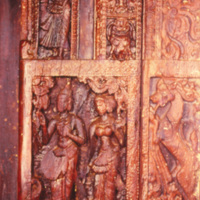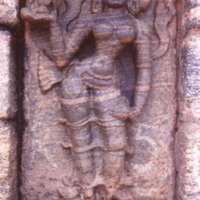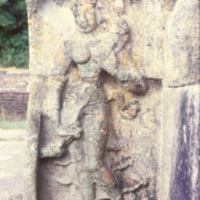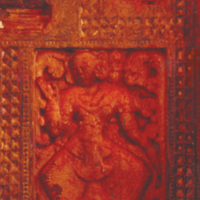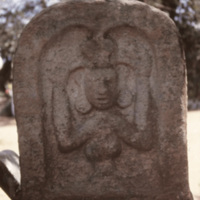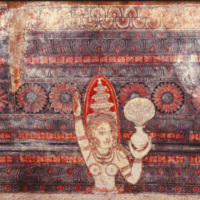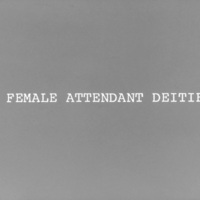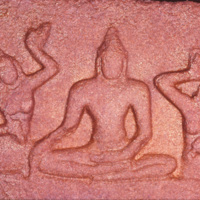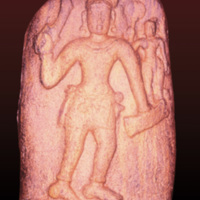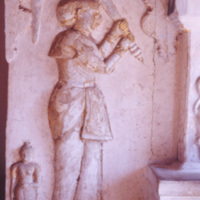Main Menu
AORC Libraries
Browse Items in Attendant Goddesses (14 total)
Guardian Deities
Description: The idea of the joint role of male and female as guardian deities is conveyed in this wood-carving at the Uda Aludeniya temple near Gampola, Sri Lanka. The couple at the bottom of the door jambs here are not represented as nagas (cobras), but there seems to be a close parallel with a stone sculpture seen at Kurunegala, Sri Lanka. Two females bearing chamaras or fly whisks are carved on two upper panels of the door jambs. They are perhaps attendant goddesses. A date in the 14th century A.D. has been suggested by scholars on stylistic grounds.
Contributor: Co-Author: Seneviratna, Harsha
Collection: Women in Sri Lankan Sculpture and Painting
Tags: AISLS, Attendant Goddesses, ICES, PDWESLSP
Female guardians
Description: On either side of the steps leading to the main building among the ruins at Yapahuva, Sri Lanka, are carved panels, with single female guardians. Although not naginis (female cobras), their shawls twirl up like cobra hoods. They carry pots of plenty symbolizing prosperity and good luck. The buildings at Yapahuva, Sri Lanka are attributed to the 13th century A.D. by art historians.
Contributor: Co-Author: Seneviratna, Harsha
Collection: Women in Sri Lankan Sculpture and Painting
Tags: AISLS, Attendant Goddesses, ICES, PDWESLSP
Carved Apsaras
Description: On the jambs of the entrance doorway at the top of the stairway at Yapahuva, Sri Lanka are carved panels of apsaras or divine maidens, carrying musical instruments, expressing devotion or bhakti. The buildings at Yapahuva, Sri Lanka, are attributed to the 13th century A.D. by historians.
Contributor: Co-Author: Seneviratna, Harsha
Collection: Women in Sri Lankan Sculpture and Painting
Tags: AISLS, Attendant Goddesses, ICES, PDWESLSP
Female dancers as guardians of temples
Description: Female door guardians or dvarapalikas in dance poses emphasize the devotional stance of these goddesses. This carved relief is at the bottom of one of the wooden door jambs at the entrance to the shrine of the main Buddhist temple at Vakirigala in the Kegalle district, Sri Lanka. Stylistically this sculpture belongs to the Kandyan period (16th-18th century A.D.).
Contributor: Co-Author: Seneviratna, Harsha
Collection: Women in Sri Lankan Sculpture and Painting
Tags: AISLS, Attendant Goddesses, ICES, PDWESLSP
Earth goddesses
Description: These two female busts are identified as the earth goddesses or polovamahikanthava who acts as guardians. They seem to rise out of the earth from their placement at the entrance to a Buddhist temple. This guardstone, is one of two found at the entrance to the precincts of the Dippitiya Vihare in the Kegalle district, Sri Lanka. The temple is dated in the Kandyan period (16th-18th century A.D.).
Contributor: Co-Author: Seneviratna, Harsha
Collection: Women in Sri Lankan Sculpture and Painting
Tags: AISLS, Attendant Goddesses, ICES, PDWESLSP
Earth goddess
Description: This painting represents the polovamahikanthava, or earth goddess, rising out of the earth as witness to the Buddha's former deeds. The personification of the earth as goddess in temple art is a popular device in the Kandyan period (16th-18th century A.D.). This painting from Degaldoruva, Kandy, Sri Lanka, is a symbolic expression of the earth rising up to bear witness to the Buddha’s deeds in earlier times.
Contributor: Co-Author: Seneviratna, Harsha
Collection: Women in Sri Lankan Sculpture and Painting
Tags: AISLS, Attendant Goddesses, ICES, PDWESLSP
Attendant goddesses
Description: Attendant goddesses, both male and female, occupying subordinate positions are a familiar occurrence in early Sri Lankan sculpture. Divine maidens bearing chamaras or fly whisks and sometimes fans, as well as female dwarfs fall into this category.
Contributor: Co-Author: Seneviratna, Harsha
Collection: Women in Sri Lankan Sculpture and Painting
Tags: AISLS, Attendant Goddesses, ICES, PDWESLSP
Divine maidens (apsaras)
Description: This is the upper section of a hero-stone where an image in the mind’s eye of the hero is shown flanked by two divine maidens or apsaras with chamaras. Ascribed to a period between the 10th and 12th centuries, this relief sculpture, seen at the Archaeological Museum in Anuradhapura, was originally found at a place known as Velanadamana, in the Vilacchi Korale of the North Central Province, Sri Lanka.
Contributor: Co-Author: Seneviratna, Harsha
Collection: Women in Sri Lankan Sculpture and Painting
Tags: AISLS, Attendant Goddesses, ICES, PDWESLSP
Divine maiden (apsara)
Description: At the Archaeological Museum, Anuradhapura, Sri Lanka is this hero stone from Polonnaruva. Here the hero appears in the divine world attended by a female bearing a fan.
Contributor: Co-Author: Seneviratna, Harsha
Collection: Women in Sri Lankan Sculpture and Painting
Tags: AISLS, Attendant Goddesses, ICES, PDWESLSP
Female attendant
Description: Placed in a palace context, this life-size sculpture of a chamara bearer of the 18th century. It is one of four brick and stucco reliefs carved on the walls of the entrance hall at the royal palace in Kandy, Sri Lanka. They may represent a realistic picture of the type of attendant of royalty during this time, or they may even represent apsaras, for divine status was an attribute of kingship.
Contributor: Co-Author: Seneviratna, Harsha
Collection: Women in Sri Lankan Sculpture and Painting
Tags: AISLS, Attendant Goddesses, ICES, PDWESLSP



